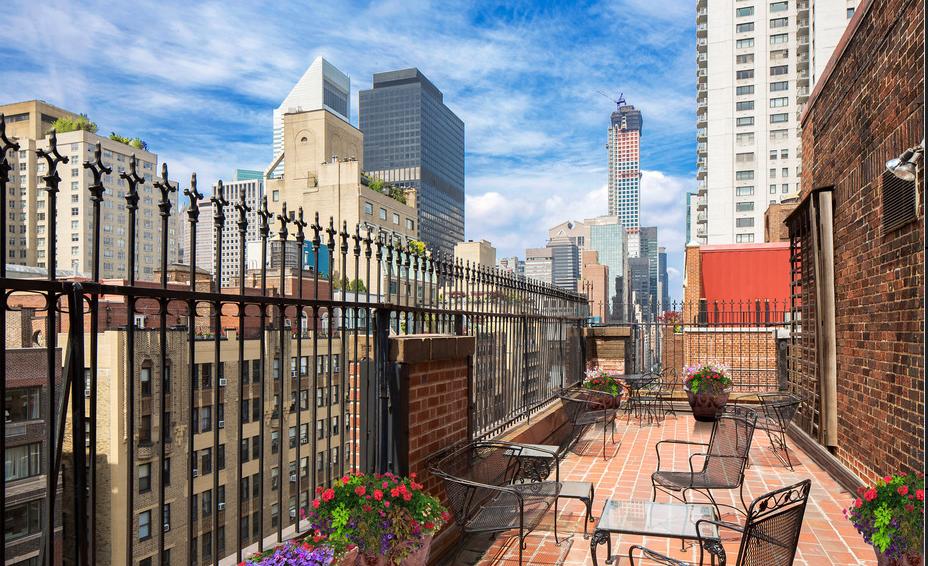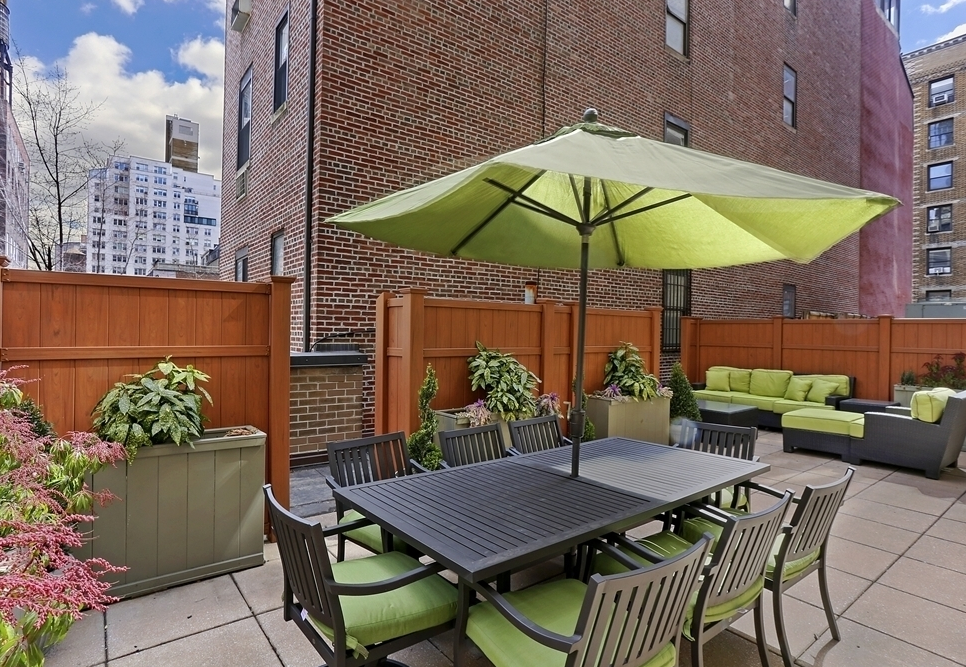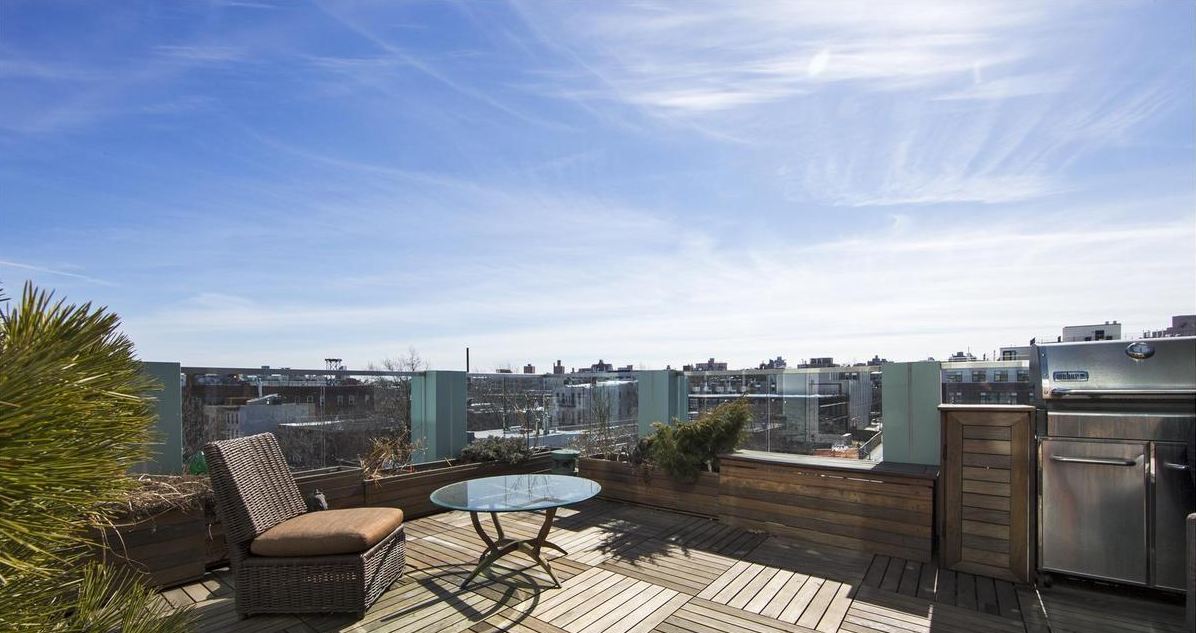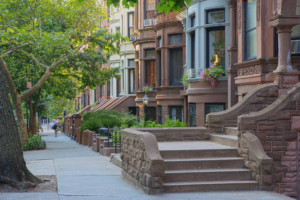Outdoor space is certainly one of the most coveted amenities for renters and buyers, but in typical New York City fashion, patios, terraces and balconies are as often used for additional storage space as they are for an outdoor retreat. Instead of terra cotta pots and chaise lounges, these spots often display cat litter boxes, bikes, sports equipment, garbage cans and other idle junk – the city’s equivalent of a suburban garage.
Of course there are plenty of New Yorkers who use their outdoor space to its full potential, but that can require serious time and financial investment. If you’re so fortunate to have a balcony or terrace, but fall into the former camp of outdoor space abusers, don’t be defeated or daunted. You can get your act together without having to invest too much time or money. Here are some tips and advice on what you need to know to make your small spit of outdoor space a relaxing and fun place to hang this summer.

Outdoor space maintenance
First things, first. If you’ve got outdoor space, you better make sure it’s safe to use before you start updating the look and feel of it. Under Local Law 11, buildings over six stories tall in New York are subject to exterior safety inspections every five years. That means an engineer or architect has to complete a review of your building’s exterior including all balconies and terraces and then file the records and results with the Department of Buildings. But just because these reviews only happen on a five-year schedule does not mean that you can overlook potential issues until the inspection rolls around.
If you notice cracks and discoloration in the pavement or surrounding walls of your terrace or balcony, take note. If over the course of several weeks or months, they grow – that’s bad! You should alert your landlord or the building board ASAP. Discoloration and cracks may be a sign that the underlying structural elements of your terrace or balcony are deteriorating.
Although the maintenance of the structural integrity of your outdoor space will most likely fallsunder the responsibility of the building board or landlord, basic maintenance and upkeep falls to you. If you have a street-facing balcony or terrace – especially a lower level one – you will certainly have some issues with soot. Be prepared to sweep and even mop regularly. If pigeons and pigeon excrement is a problem, you can hang netting around your balcony or erect bird-repellant spikes along the edges of balcony railings. If you feel that gives your outdoor space too much of a draconian look, you can go try more humane solutions such as setting up a scarecrow or applying some non-toxic bird repellent spray to the surfaces of your terrace or balcony.

Planting on your terrace or balcony
Aesthetic landscaping choices aside, the biggest issues to keep in mind when planting on your terrace or balcony are the weight of your planters and water drainage. If you’re considering using planters on your terrace, make sure that the terrace can hold the weight. Check with your landlord or co-op board to see if there are any weight limitations or recommended weight capacities. When placing your planters, be sure that they don’t block or hinder doorways or vents – impeding access to exits and blocking air vents are fire deemed fire hazards. Your planters will also been proper drainage or else water will collect under them which can lead to deterioration and issues with muddy water runoff. Most planters have built-in drainage systems, but be sure to check before purchasing.
The plants you choose for your terrace or outdoor space is really up to you and what the micro-environment of your outdoor space can sustain. It’s important to think about sun and wind exposure – especially if you’ve got rooftop outdoor space. If you’re close to the street, avoid delicate buds that can easily be damaged and perhaps opt for sturdy shrubs or bushes instead.

Decoration
The décor and design of your outdoor space is up to you so long as you don’t plan to set up an permanent structures (a greenhouse or cabana if that strikes your fancy, for example). If you are ambitious about your outdoor space and planning such a project, cheers to you and be sure to get board approval before doing so. If you have humbler aspirations for your outdoor space (just a picnic table or umbrella, perhaps?), then you don’t need approval from the board or your landlord. That said, if your terrace or balcony is visible from the street, the building board may not want you hanging Christmas lights, pirate flags, laundry or other bold decorations on your outdoor space. You should check the co-op or building bylaws to see if they have any guidelines or outdoor décor rules before investing in your next skull and cross bones banner.
If you have large, light items, like umbrellas and plastic patio furniture, consider storing them inside — especially if your balcony or terrace is in a windy area. You don’t want to cause any hazards by means of flying patio furniture.

Grilling
So you’ve gotten your outdoor space all structurally sound, landscaped and decorated. What better way to show it off than a cookout, right? Yes, you would think so but before inviting the whole building and everyone you know over, you ought to bone up on the rules and regulations around grilling at home in New York City. As it turns out, the FDNY has some pretty strict rules about where you can grill and what kind of grill you can have at your home. Here’s a basic rundown of what the code mandates. For complete information, refer to the FDNY guidelines.
• All grills (propane gas or charcoal) must be kept in an open area, at least 10 feet from the building, deck railings and out from overhanging eaves.
• All grill areas must be accompanied by a garden hose or bucket of sand to extinguish flare-ups
• You cannot use or store propane grills on the roof of any building
• You cannot use charcoal grills on the roof of any building
• You cannot store or use a propane grill on the terrace or balcony of any building
Sounds pretty bad, right? Although people seem to disregard the rules, the FDNY does prohibit grilling in most apartment building in New York City. The guidelines do leave room for you to interpret the rules such that you could use and store a grill in the backyard of building, as long as it is 10 feet away from the structure. But since they also stipulate that you cannot carry a tank of propane through a building out to the other side, you can’t actually set up a propane grill and tank in your back yard anyway. That said you have a charcoal grill in your backyard – as long as it is 10 feet away from the building.
Apartment dwellers and grill sellers without a doubt turn a blind eye to these rules and it honestly seems like a shame to pay premium prices for an apartment with outdoor space and not be able to enjoy it as you please – or the very least without being able to fire up the grill come summer. In many cases owning and using a grill in your private outdoor space will go unnoticed by the powers that be, but it only takes one curmudgeonly neighbor to rain on your barbeque by filing a complaint with the FDNY. So review the guidelines carefully and grill safely and quietly.











